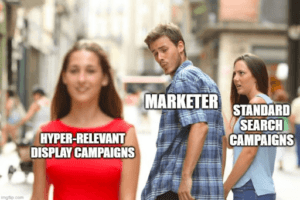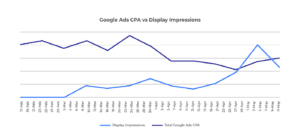3 Tips To Improve Your Paid Search Marketing Post-COVID
COVID has transformed nearly every aspect of the day-to-day routine in America. For many of us it involves scrambling to find child care, completing services ourselves that we once paid others for, and rediscovering old pastimes.
For nearly 40 million of us, it’s finding new employment. Lastly, for an unfortunate few of us, it’s grieving the loss of loved ones. Remembering the holistic impact COVID has had on the American populace is vital in finding success with any marketing campaign, regardless of channel, as life and the daily pace of the economy continues onward.
Over the last few months several businesses stopped or severely cut marketing budgets due to declining revenue or temporarily closing up shop. Those that fall into this category are likely due for a surprise when they start their SEM campaigns back up again.
For many verticals & geographic regions, search traffic is substantially down. Others are finding traffic relative to when they were live but user behavior drastically different.
This should not be a shock. Traffic for the term ‘unemployment’ on Google has increased 14x when comparing April 5th to early February. Correspondingly, conversion rates have fallen for a vast majority of verticals since March. People and businesses simply have less money to spend or feel less comfortable spending it.
Looking at this data, it can’t be overstated what the main function of Google Search and an SEM ads are.
People use Google to find answers. If they are looking for the ‘cheapest oil change’ near them, and you run an SEM ad that is priced higher than your competitors, you are nearly guaranteed to be spending your limited advertising budget at a loss. Don’t bid on a query you are not the answer for!
Of course it’s not as simple as having your ad be an answer. If so, SEM ad spend wouldn’t be down nearly 30% to 50%.
Here are some tips to help you get your SEM campaigns back live at a profit.
Tip 1: Can you restructure physical transaction points to online? Do it!
Global searches related to buying online have skyrocketed nearly 70% since the beginning of 2020. Just in March of this year alone, ecommerce sales have grown 20% from March 13th – 15th compared to the baseline created by March 1st – 11th.
On a very basic level this makes sense as several states and countries enforced social distancing practices to slow the spread of COVID. While there are many milestones to report on, what may be shocking to many business owners is that data trends are showing this behavior is here to stay.
Make sure you are ahead of this curve and not behind it! As shoppers transfer more to online orders, brand affinities are going to be reset as well. If you are not digital as your once brick and mortar customer base moves their purchasing habits online, they will find a business that is.
Tip 2: Embrace the loss early on
As noted earlier, conversion rates are down overall. This trend, however, is unlikely to stay. Now is an opportune time to expand your customer base with awareness campaigns and enticing promotions.
If you are starting your SEM campaigns back up after being down for a month or so, the following are simply going to be a fact of life:
- Quality scores have to be built back up
- User site behavior is going to be different and re-reviewed after going back live
- Past successful ad copy, for most verticals, will need to be revised to reflect the current consumer & business mindset
Issue 1: Building quality scores back up
The best way to build up quality scores is to re-focus on the basics. Ensure every possible ad extension is enabled, your landing pages reflect the keyword and ad copy, and ad group keyword segmentation is as specific as possible. Increase CTRs with a unique and competitive promotion to entice users to click your ad over the competition’s.
 Issue 2: Re-reviewing user site behavior
Issue 2: Re-reviewing user site behavior
Many businesses are not going to be able to survive on SEM traffic alone. Now is a phenomenal time to try out those fancy display campaigns you’ve heard about. This doesn’t mean bankrolling Google’s next R&D fiasco with your marketing budget, but accepting higher CPAs with considerably lower CPCs to rebuild your site traffic back up.
While a promo may lower profit per transaction at this moment in time, the lifetime value of a customer for most verticals will more than make it up. Additionally, the lower CPCs of a well managed display campaign will allow you to see post-COVID user behavior. You can harness this data to shorten the ramp-up time to higher conversion rates and lower CPAs.
At Defero, we executed this strategy for a B2C client who remained open during the COVID shutdown. The client was never fully on-board with display campaigns in the past as they were pleased with their success running standard SEM alone. However, around February 23rd they were no longer able to sustain on only search campaigns due to COVID traffic changes and allowed us to alter course completely.
We executed on two main fronts, an enticing new promotion and hyper-relevant display campaigns to create awareness. At first the display campaigns were to inform potential customers the business was still open and of the new promotion for essential workers. This brought in more users to the site than search could at a much cheaper cost.
Based on their site behavior and interactions with the new promo, we then further segmented the audiences we were targeting to create greater efficiencies within a manner of weeks. CPA then lowered to pre-COVID numbers which inspired the client to dedicate marketing to conversion volume over efficiency for future growth.
Issue 3: Revising Ad Copy
Avoiding the elephant in the room will come at the cost of ROI of SEM marketing efforts. There’s no need to wax poetic about the chaos caused by COVID as many companies have chosen to do on television & YouTube ads, but the issue has to be addressed.
On an SEM ad, you only have up to 270 characters to get your point across. Often, people stop reading after the first 60 characters of the headline! So, just remember the aforementioned search data above.
Americas are budget conscious as they see others or themselves lose employment and they’re worried about their family’s health. If you reflect those two issues via operational changes and cost saving options to them, you are likely to break the trend rather than follow it.
Tip 3: Transition back to efficiency and profitability
Once search and site traffic is back to pre-COVID numbers, the focus should be on wrapping all that data together, comparing pre-COVID to COVID date ranges, and adjusting where necessary.
Many businesses are likely going to see that their budget allocations by service or product need to be revised as user behavior has permanently altered. Additionally, ad copy differentiators of the past may not be as effective in the future.
You don’t want to completely forget where you found your success prior to COVID, but you don’t want to hang your hat on that data as well. Accept with an open heart that your customers may want a different relationship with your business and vertical going forward. Companies that accept that sooner rather than later will have a head start on the competition.

